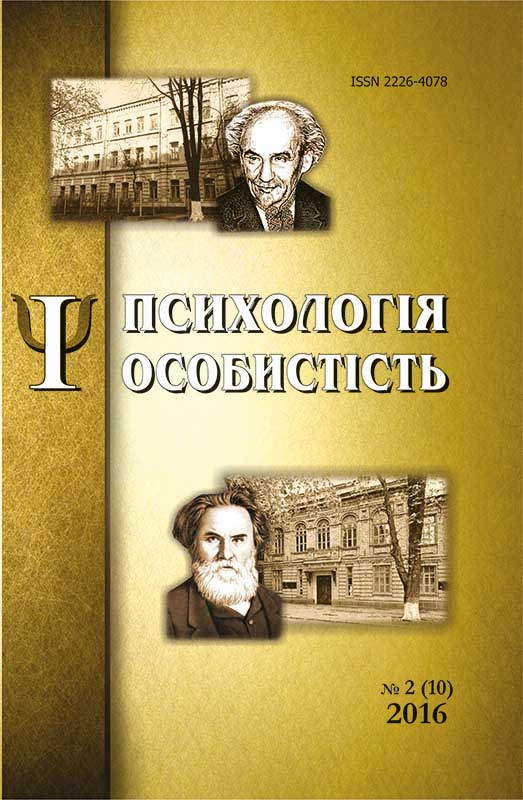Особливості копінг-стратегій учасників бойових дій в зоні АТО
DOI:
https://doi.org/10.33989/2226-4078.2016.2.163241Ключові слова:
АТО, копінг-стратегія, травматична ситуація, посттравматичний стресовий розлад, бойовий стресАнотація
Стаття присвячена теоретичному та емпіричному дослідженню копінг-стратегій добровольців, мобілізованих та кадрових військових-учасників бойових дій у зоні АТО. Виявлено відмінності у застосуванні копінг-стратегій між добровольцями і мобілізованими солдатами. Встановлено зв’язки між інтенсивністю симптомів ПТСР та копінг-стратегіями військовослужбовців. Досліджено рівень бойового досвіду та його вплив на вибір копінг-стратегій.Посилання
Goldberg J, True W, Eisen S, Henderson W. A twin study of the effects of the Vietnam War on posttraumatic stress disorder Journal of the American Medical Association.1990. No. 263. P. 1227-1232.
APA (American Psychiatric Association). Diagnostic and Statistical Manual of Mental Disorders, Fourth Edition, Text Revision (DSM-IV-TR). Washington, DC: American Psychiatric Publishing Association, 2000.
Bartone P. T. Hardiness protects against war-related stress in Army Reserve forces / P. T. Bartone. Consulting Psychology Journal: Practice and Research. 1999. 51. P. 72-82.
Hoge C, Messer S, McGurk D Combat duty in Iraq and Afghanistan, mental health problems, and barriers to care The New England Journal of Medicine. 2004. No. 351. P. 13-22.
Wolfe J., Erickson D., Sharkansky Course and predictors of posttraumatic stress disorder among Gulf War veterans: A prospective analysis. Journal of Consulting and Clinical Psychology. 1999. No. 67. P. 520-528.
Fontana A., Rosenheck R Traumatic war stressors and psychiatric symptoms among World War II, Korean, and Vietnam War veterans Psychol Aging. 1994. P. 27-33.
Hyams K., Wignall F., Roswell R. War syndromes and their evaluation: From the U.S. Civil War to the Persian Gulf War. Annals of Internal Medicine. 1996. No. 125. P. 398-405.
McCarroll JE, Ursano RJ, Fullerton CS, Liu X, Lundy A. 2001. Effects of exposure to death in a war mortuary on posttraumatic stress disorder symptoms of intrusion and avoidance.
Kang H, Natelson B., Mahan C. Post-traumatic stress disorder and chronic fatigue syndrome-like illness among Gulf War veterans: A population-based survey of 30,000 veterans. Am. J. Epidemiol. 2003. No. 157. P. 14-18.
Stretch R., Marlowe D., Bliese P. Post-traumatic stress disorder symptoms among Gulf War veterans. Military Medicine. 1996. No. 161. P. 407-410.
Prigerson H., Maciejewski P., Rosenheck R. Population attributable fractions of psychiatric disorders and behavioral outcomes associated with combat exposure among US men. Am. J. Public Health. 2002. No.92. P. 59-63.
Shephard B. A. War of Nerves: Soldiers and Psychiatrists in the Twentieth Century Cambridge: Harvard University Press, 2001.
Toomey R, Kang HK, Karlinsky J, Baker DG, Vasterling JJ, Alpern R, Reda DJ, Henderson WG, Murphy FM, Eisen SA. 2007. Mental health of U.S. Gulf War veterans 10 years after the war.
Kulka R., Schlenger W. Fairbank Trauma and the Vietnam War Generation: Report of Findings from the National Vietnam Veterans Readjustment Study. Journal of Traumatic Stress. 1992. P. 321–322.
Sutker P., Uddo M., Brailey K., Allain A. War-zone trauma and stress-related symptoms in Operation Desert Shiel/Storm (ODS) returnees. Journal of Social Issues. 1993. No. 49. P. 33-49.





